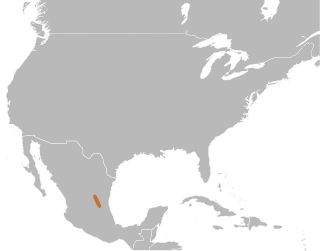
Hypsiglena is a genus of small, rear-fanged, colubrid snakes commonly referred to as night snakes. The genus consists of nine species, and subspecies have been maintained pending further investigation.
The night snake is a species of rear-fanged colubrid. It is found in Mexico.

Hypsiglena jani, commonly known as the Texas night snake or the Chihuahuan night snake, is a small species of mildly venomous snake in the family Colubridae. The species is native to the southwestern United States and adjacent northeastern Mexico.

Giorgio Jan was an Italian taxonomist, zoologist, botanist, herpetologist, and writer. He is also known as Georg Jan or Georges Jan. He was the first director of the natural history museum at Milan.

The California night snake is a subspecies of small colubrid snake native to California.
Sauromalus slevini, also known as the Monserrat chuckwalla or Slevin's chuckwalla, is a species of chuckwalla belonging to the family Iguanidae. S. slevini is native to three small islands in the Sea of Cortés.

Pseudalsophis is a genus of snakes in the family Colubridae. The genus is endemic to South America.
Hypsiglena unaocularus, commonly known as the Islas Revillagigedo night snake or Clarión night snake, is a species of small colubrid snake endemic to Clarion Island, initially described from a single specimen collected by William Beebe in 1936. During the next several decades, scientists were unable to detect any trace of the snake in their field studies. After an intensive search in 2013, a team of scientist identified 11 snakes that matched the original description of the species. They conducted a series of DNA tests to confirm that the Islas Revillagigedo nightsnake, formerly viewed as the subspecies Hypsiglena torquata unaocularis, is genetically distinct from related mainland snakes and should be recognized as a full species. While never formally declared extinct, this species remained absent from scientific literature due to two main factors: its home on Clarion is extremely remote and only accessible by military escort, significantly restricting the number of biologists who can access this area, and the snake's secretive, nocturnal behavior and dark coloration make it difficult to detect in the field. Because of the lack of follow-up sightings, scientists long presumed that Beebe had provided an incorrect locality for his specimen.
Isla Danzante, is an island in the Gulf of California east of the Baja California Peninsula. The island is uninhabited and is part of the Loreto Municipality.
Isla Coronados, is an island in the Gulf of California east of the Baja California Peninsula in Baja California Sur state, Mexico. The island is uninhabited and is part of the Loreto Municipality.
Isla Mejia is an island in the Gulf of California east of the Baja California Peninsula. The island is uninhabited and is part of the Mexicali Municipality.

Joseph Richard Slevin was an American herpetologist and the second curator of herpetology at the California Academy of Sciences, with which he was affiliated for over 50 years. He collected reptile and amphibian specimens from around the world, notably in the Galápagos Islands in a 17-month expedition, and was largely responsible for re-growing the academy's herpetological collection following its destruction in the 1906 San Francisco earthquake. He wrote or co-wrote nearly 60 scientific papers, and is commemorated in the scientific names of over a dozen species or subspecies of animals and plants.
Hypsiglena catalinae, the Isla Santa Catalina night snake, is a species of snake in the family Colubridae. The species is native to Mexico.
Hypsiglena chlorophaea, the desert night snake, is a species of snake in the family Colubridae. The species is native to Mexico and the United States.

Hypsiglena ochrorhynchus, the spotted night snake, is a species of snake in the family Colubridae. The species is native to Mexico and the United States.

Hypsiglena tanzeri, the Rio Verde night snake or Tanzer's night snake, is a species of snake in the family Colubridae. The species is native to Mexico.

Pseudalsophis slevini , the banded Galapagos snake, is a species of snake of the family Colubridae.
Trimetopon slevini, Slevin's tropical ground snake, is a species of snake in the family, Colubridae. It is found in Costa Rica and Panama.
Masticophis slevini, the Isla San Esteban whip snake, is a species of snake found on San Esteban Island in Mexico.








